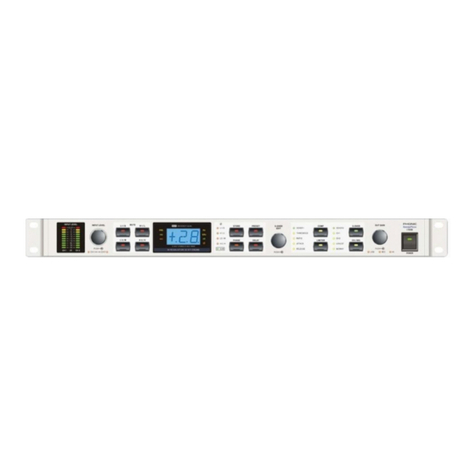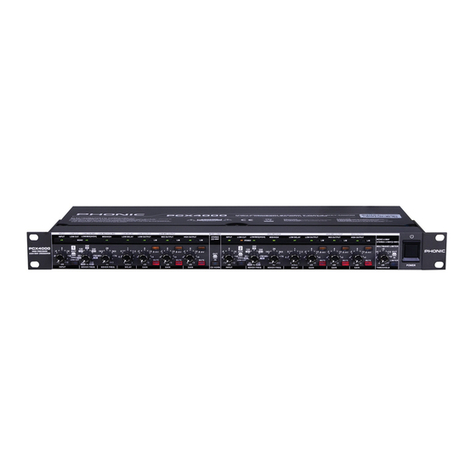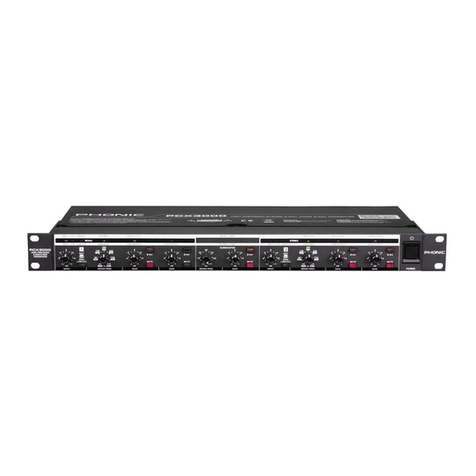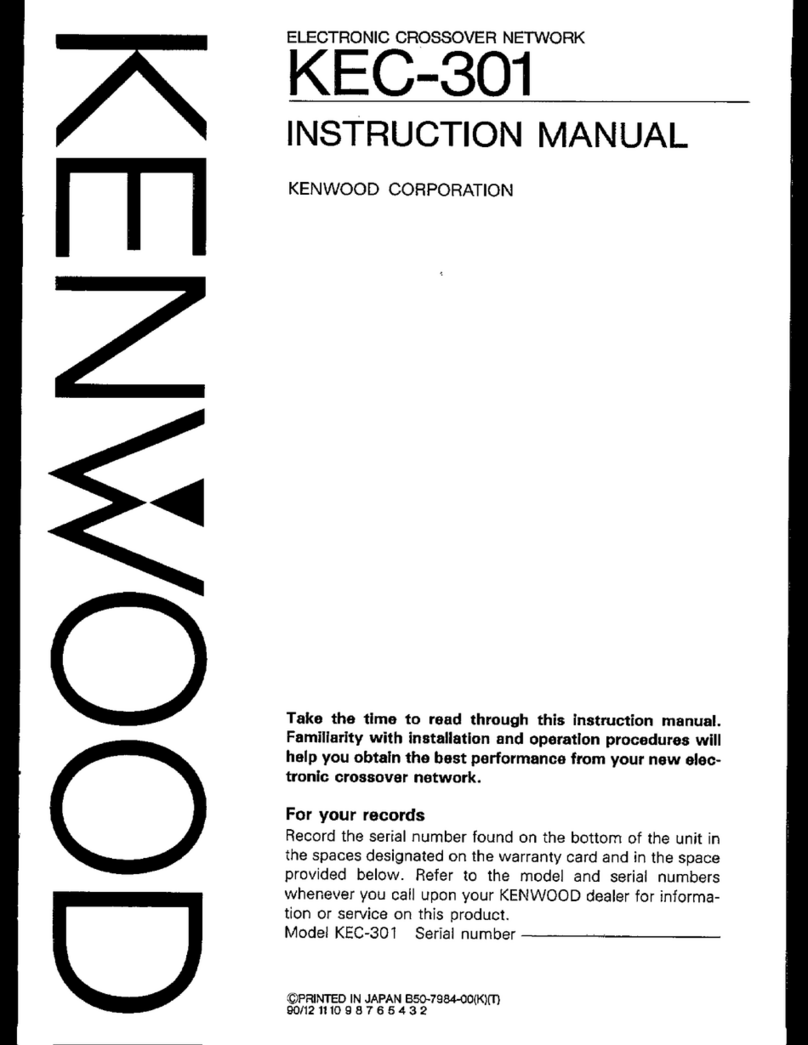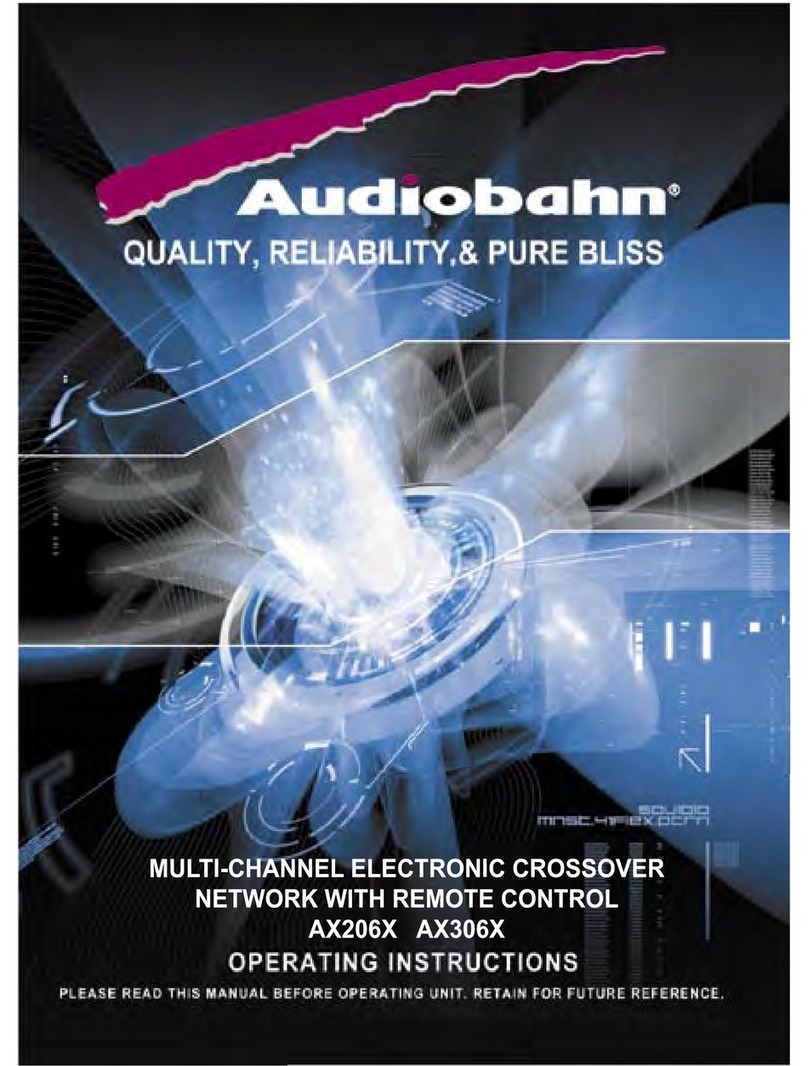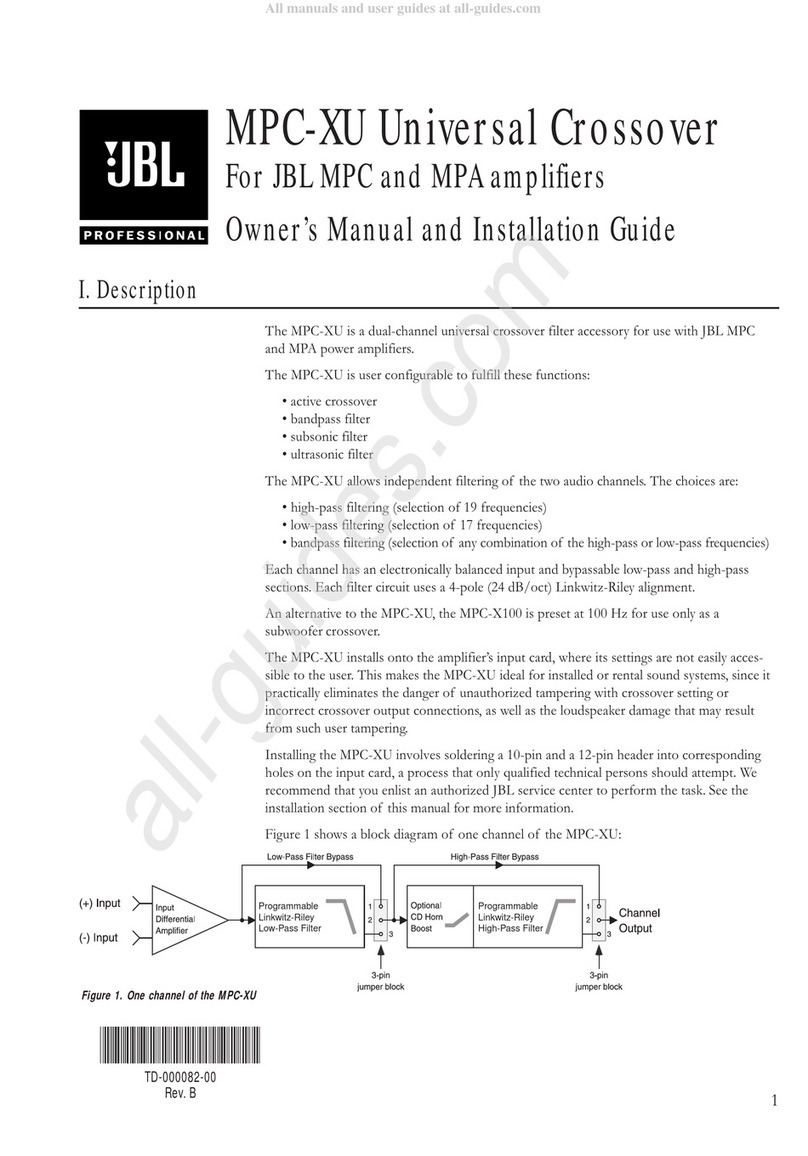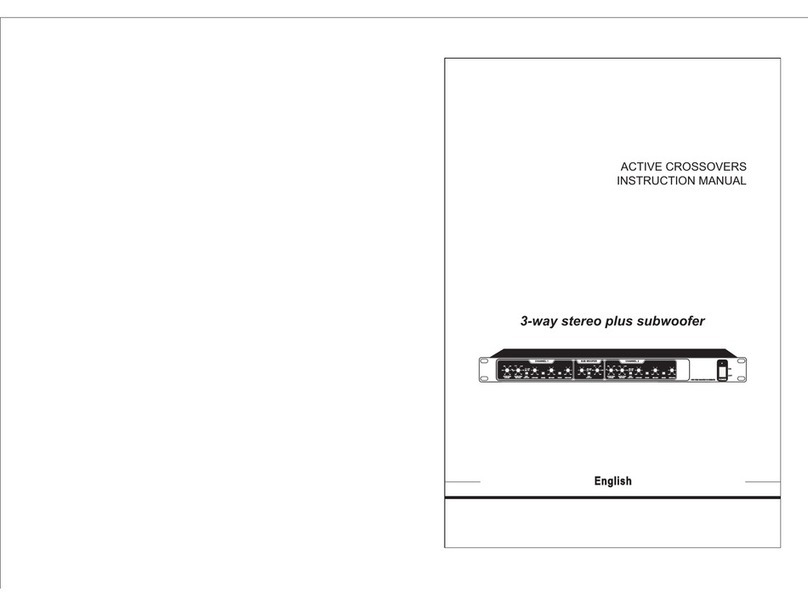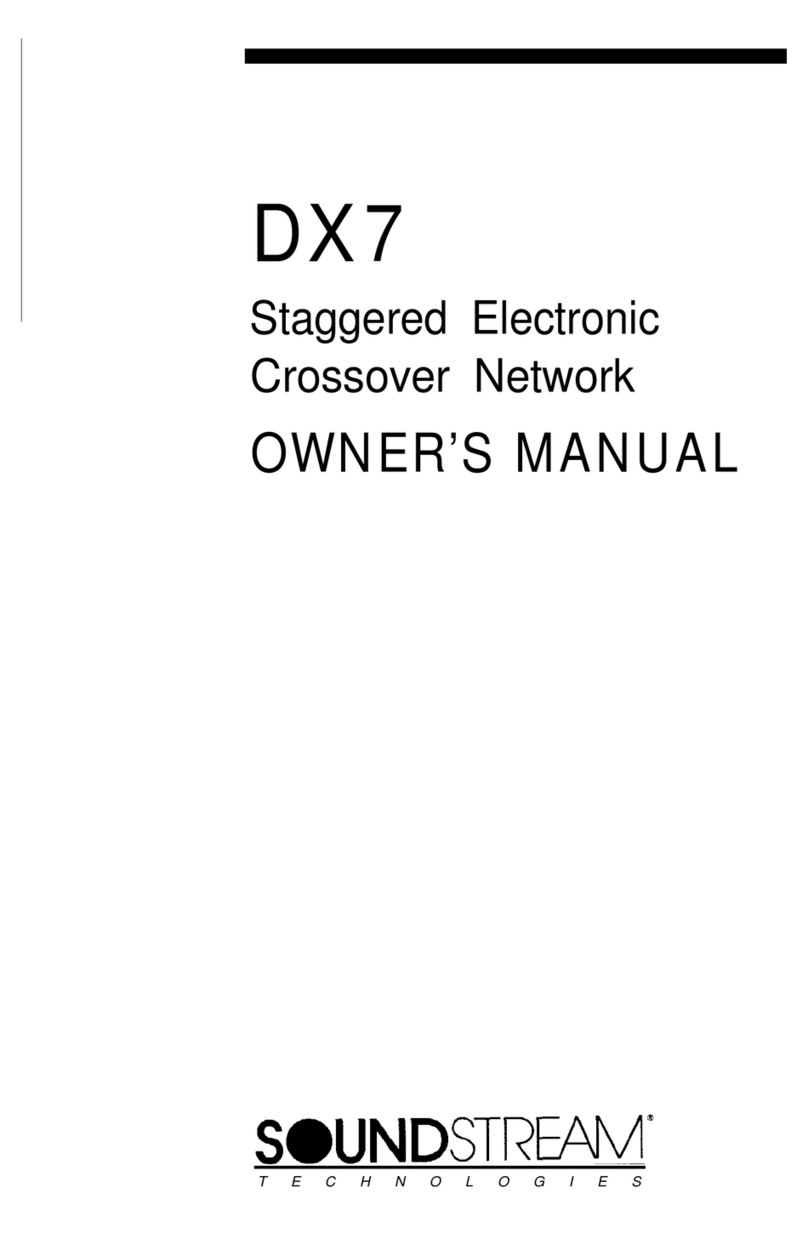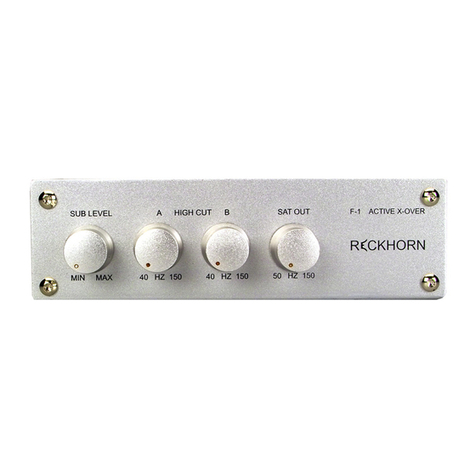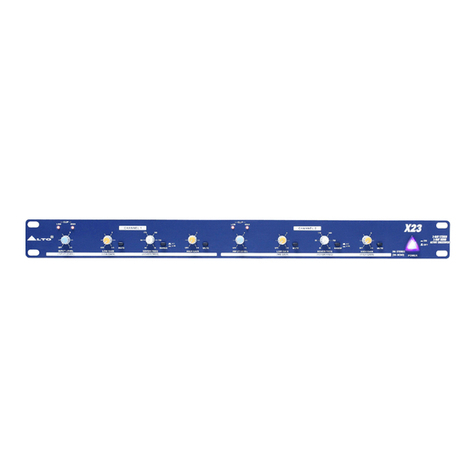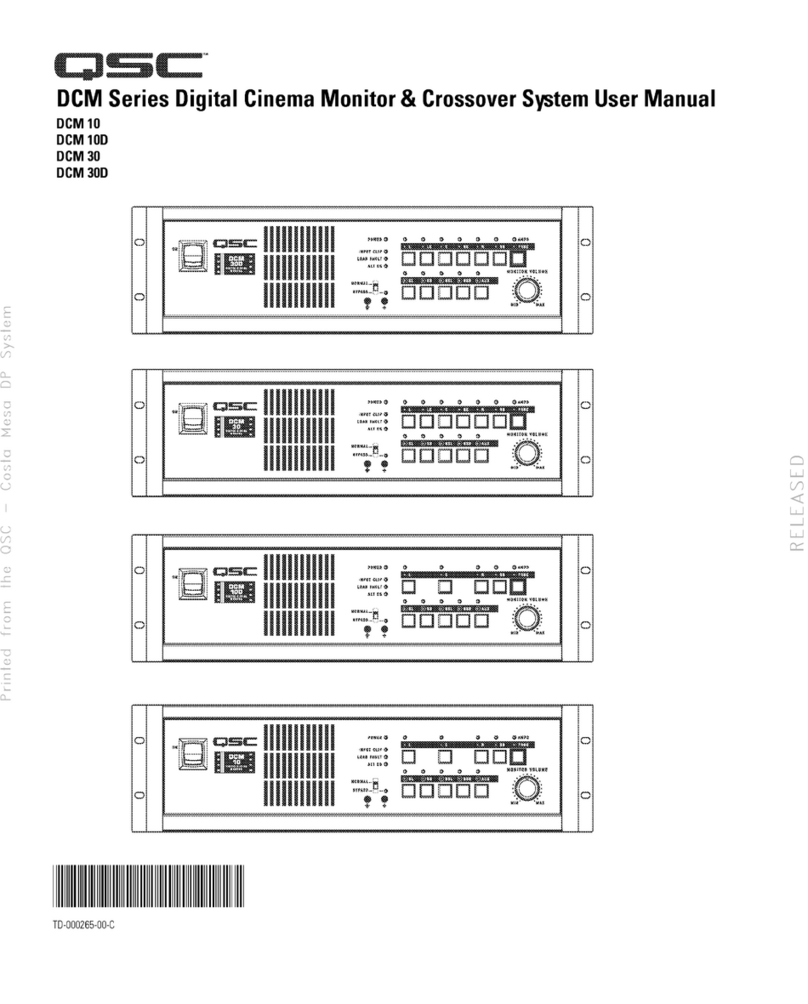Phonic PCR2213 Plus User manual

PCR2213 User's Manual
Manual del Usuario

ENGLISH ..................................................I
ESPAÑOL ..................................................II
V1.1 06/07/2012
ACTIVE CROSSOVER
CROSSOVER ACTIVO
PCR2213
English Español

PCR2213 3
English
PREFACE1
DESIGN YOUR SPEAKER SYSTEM WITH PCR2213 Plus2
INSTALLATION7
CONTROLS8
HOW TO SET UPA MULTI-WAY SYSTEM11
SPECIFICATIONS14
APPENDIX
TYPICAL CONNECTING LEADS1
SYSTEM BLOCK DIARGRAM2
CONTENTS
User’s Manual
Phonic preserves the right to improve or alter any information within this
document without prior notice

PCR22134
English
1. Read these instructions before operating this
apparatus.
2. Keep these instructions for future reference.
3. Heed all warnings to ensure safe operation.
4. Follow all instructions provided in this document.
5. Do not use this apparatus near water or in locations
where condensation may occur.
6. Clean only with dry cloth. Do not use aerosol or liquid
cleaners. Unplug this apparatus before cleaning.
7. Do not block any of the ventilation openings. Install
in accordance with the manufacturer
’
s instructions.
8. Do not installnearany heat sources such as radiators,
heat registers, stoves, or other apparatus (including
.
9. Do not defeat the safety purpose of the polarized or
grounding-type plug.Apolarized plug has two blades
with one wider than the other. A grounding type plug
has two blades and a third grounding prong. The wide
blade or the third prong is provided for your safety. If
the provided plug does not into your outlet, consult
an electrician for replacement of the obsolete outlet.
10. Protect the power cord from being walked on or
pinched particularly at plug, convenience receptacles,
and the point where they exit from the apparatus.
11. Only use attachments/accessories by the
manufacturer.
12. Use only with a cart, stand, tripod, bracket, or
table by the manufacturer, or sold with
the apparatus. When a cart is used, use caution
when moving the cart/apparatus
combination to avoid injury from tip-
over.
13. Unplug this apparatus during lighting
storms or when unused for long
periods of time.
14. Refer all servicing to service personnel.
Servicing is required when the apparatus has been
damaged in any way, such as power-supply cord or
plug is damaged, liquid has been spilled or objects
have fallen into the apparatus, the apparatus has
been exposed to rain or moisture, does not operate
normally, or has been dropped.
IMPORTANT SAFETY INSTRUCTIONS
CAUTION: TO REDUCE THE RISK OF ELECTRIC SHOCK,
DO NOT REMOVE COVER (OR BACK)
NO USER SERVICEABLE PARTS INSIDE
REFER SERVICING TO QUALIFIED PERSONNEL
The lightning flash with arrowhead symbol, within an
equilateral triangle, is intended to alert the user to the
presence of uninsulated
“
dangerous voltage
”
within the
product
’
magnitude to constitute a risk of electric shock to persons.
The exclamation point within an equilateral triangle is in-
tendedtoalerttheusertothepresenceofimportantoperat-
ingandmaintenance(servicing)instructionsin theliterature
accompanying the appliance.
WARNING: To reduce the risk of or electric shock, do
not expose this apparatus to rain or moisture.
CAUTION: Use of controls or adjustments or performance
of procedures other than those may result in
hazardous radiation exposure.
The apparatus shall not be exposed to dripping or splashing and that no objects with liquids, such as vases,
shall be placed on the apparatus. The MAINS plug is used as the disconnect device, the disconnect device shall
remain readily operable.
Warning: the user shall not place this apparatus in the area during the operation so that the mains switch
can be easily accessible.
CAUTION
RISK OF ELECTRIC SHOCK
DO NOT OPEN

PCR2213 1
English
1.0 PREFACE
In most of the professional audio applications, multiple speakers
are employed for covering the whole audience area as well as
frequency band. When sound waves are generated with multiple
speakers, proper arrangement is a standard and recommended
practice by audio design engineers and installation technicians.
Phonic provides this active crossover as part of the speaker sys-
tem, which work together with speaker drivers, highs or lows, and
ampliers, big or small. This crossover will be successful if you
carefully design and align the whole speaker system according to
the following explanation and recommended practice.
1.1
MULTIPLE-WAY SPEAKER SYSTEMS
Full bandwidth covering 20Hz to 20KHz as human audible band,
no single speaker driver can cover this range with wave length
differ by 1000 times with good quality and sufcient sound pressure
level. To deal with this limit, audio engineers need to use multiple
speaker drivers for different frequency band, and we call these
designs as multiple-way system. Multiple-way means different
speakerscoveringdifferentfrequencyband,andmultiplespeakers
could be in the same band. For professional applications, 2-way
and 3-way designs are most popular conguration. To build a 2-way
or 3way speaker system, crossover network is needed to divide
the frequency band into high and low (or high, mid, low) section.
Crossover can be passive or active. Passive crossover can be
foundin smaller speakersystemthat isassembledwith inductors,
capacitors, and resistors. Amplier send in the signal to the passive
crossover network and then to the high and low frequency speak-
ersaccordingly.Activecrossoverdid thisdifferently, it ispositioned
before the power ampliers. Then, the power amplier send the
signaldirectlytothehighorlowfrequencyspeakersdirectlywithout
the passive crossover inserted. The benet are:
More solid bass for lower resistance between speaker and
amplier that maintain effective damping factor.
Lower inter-modulation distortion (IMD).
Save the insertion loss, normally in the range of 1 to 3 dB.
That means save the lost from 20% to 50%.
Increase power efciency for less composite signal that
will demand lower voltage swing of power ampliers, and
still provide the same sound pressure level.
Save the high frequency drivers from damage by large
low frequency signal clipping the power ampliers
which generate high level harmonic signal. This is the
phenomenon that underpower amplier will burn tweeter
when clipping.
Iftheuserdoesn’tfollowtheexactproceduretoset-upthespeaker
system with active crossover, the result is always very bad and
worst than passive crossover speakers. Because the passive
crossover was already properly adjusted by the designer and
maker.
OK, let’s see how we can get the best of the system performance
with Phonic PCR2213 Plus.
1.2 PCR2213 Plus THE ULTIMATE
CROSSOVER FOR ADVANCED
SPEAKER SYSTEM
The PCR2213 Plus is a very high quality active crossover. It is
designed with 2, 3 or more way speaker systems in
mindwith 1,2 ormore PCR2213Plus toachieve it.ThePCR2213
Plus may be used with large sound systems in
auditoriums,theaters,pubs,amusementparks,ortouringconcerts.
Also for high quality bi-amp stage monitors,
or adding a mono sub-woofer for studio monitors in a control
room.
The Phonic PCR2213 Plus is a high precision tool with a lot of
advanced features:
Stereo 2-way or mono 3-way operation.
Reasonable ways speaker system with multiple PCR2213
Plus.
Industrial standard state variable 24 dB/octave
Linkwitz-Riley lters with zero phase error at crossover
frequencies.
Perfect at summed amplitude response at all Crossover
frequencies.
Independent limiters on all outputs with pre-dened time
parameters.
Latching mute push buttons on all outputs. It is a vital
function during setting up and troubleshooting.
LED indication on all important switching functions for
easy status identication.
Crossover frequencies continuously variable from 80 -
8000 Hz
Time/phase alignment via polarity switches and 4 msec
time delay controls
Switchable horn EQ curve to compensate the HF roll-off.
RF and Subsonic input lters.
High precision components and potentiometers ensure
excellent quality and accuracy of settings
Servo-balanced XLR inputs and outputs

PCR22132
English
2.0 DESIGN YOUR SPEAKER SYSTEM WITH PCR2213 Plus
When designing the speaker system, rst determine the frequency bandwidth you want to cover and the maximum sound pressure level
you want to achieve. Select those components that meet your demand. Carefully note the frequency range each driver covered. Following
are some most popular conguration, PCR2213 Plus is not limited within the listed application. Multiple PCR2213 Plus can form even more
than10-wayspeakersystem, although it is not practical.The recommendedcrossoverpointsare listed foryour reference, your components
will fall in the recommended range mostly, but exception exists!
2.1 2-WAY SYSTEM (Ref:Figure 1)
PCR2213 Plus is capable of dual 2-way system in stereo mode. The crossover frequency can be anywhere between 80 to 8000Hz. Most
2-way system crossover between 500 to 5000Hz. Following are the table of popular 2-way conguration and recommended crossover
frequency:
Figure 1: Typical Active 2-way System

PCR2213 3
English
2.2 3-WAY SYSTEM (Ref:Figure 2)
PCR2213 Plus is capable of single 3-way speaker system with one unit. The low/mid and mid/high crossover frequency can be set between
80 to 8000Hz. Most 3-way system have low/mid crossover point at 200~2000Hz, and mid/high at 800~8000Hz. Following are the table of
popular 3-way conguration and recommended crossover frequency:
Figure 2:Typical Active 3-way System

PCR22134
English
2.3 PASSIVE FULL RANGE WITH ACTIVE-CROSSOVER SUB-WOOFER (Ref:Figure 3)
PCR 2213 is very suitable for sub-woofer application and is capable of this system with one unit. The crossover frequency is always low
at 80~200Hz. Following a table to list some popular conguration:
Figure 3:Typical Passive 2-way + Subwoofer
PCR 2213 has a sub-switch in the rear panel. This switch will sum the low frequency part of both channels and send it out from both low
outputs. When you are using this type of speaker system with one or more sub-woofer boxes, it is recommended to engage the switch and
put all the woofer boxes together in the center line between the stereo speakers.

PCR2213 5
English
2.4 STEREO ACTIVE 2-WAY WITH SUB-WOOFER (Ref:Figure 4)
Some people will regard this as 3-way, and it really is. There are 2 conguration you can achieve:(1)Treat it as 3-way and do it as the same
as 2.2. (2)Treat it as 2-way plus sub-woofer as the same as 2.1 + 2.3.
The later conguration benet the summed sub-woofer output from both channels, and thus better than pure 3 way conguration. No matter
which conguration, you need two PCR2213 Plus for this system.
Figure 4:Typical Active 2-way + Subwoofer

PCR22136
English
2.5 STEREO ACTIVE 3-WAY WITH SUB-WOOFER
Some people will regard this as 4-way. But most 4-way system is actually 3-way plus sub-woofer. There are 2 conguration you can
achieve: (1)Treat it as 4-way and put two PCR 2213 in each channel, you will need four PCR 2213. (2)Treat it as 3-way plus sub-woofer
as the same as 2.2 + 2.3, and you are using three PCR 2213 for the whole system. The later conguration benet the summed sub-woofer
output with both channel, and saves you one PCR 2213. Although we appreciate if you would like to buy more unit, but technically we
don’t suggest this conguration.
2.6 4-WAY, 5-WAY ......
You can always achieve multiple ways system with multiple PCR2213 Plus, always send the next PCR2213 Plus with low frequency output
for easiest time alignment. Following the table for various ways conguration:

PCR2213 7
English
3.0 INSTALLATION
3.1 RACK MOUNTING
The Phonic PCR2213 Plus ts into standard rack, and takes one
unitheightofspace(1 3/4”).Additional4”depthfor the connectors
onthebackpanelisneeded.Besurethatthereisenoughairspace
around the unit for cooling and please do not place the PCR2213
Plus in contact to or directly on top of high temperature devices
such as power ampliers etc. to avoid overheating.
3.2 CONNECTORS
ThePCR2213Plushasto be connectedwithXLRplugs.Although
theinputsandoutputsarefullybalanced,theactiveservocircuitry
can be wired with unbalanced sources and loads as well.
3.2.1 Impedance
Both of the inputs impedance are 20k Ohms and can be driven by
most sources. If a device’s output requires a match load of 600
Ohms(mostlyfromoutputtransformers),600Ohmsresistorshould
be tied across pin 2 and 3 on the input connectors. As standard,
the outputs of the PCR2213 Plus are electronically balanced and
have an output impedance lower than 100 Ohms. When driving
transformer coupled loads, it may be necessary to create a 600-
Ohm source impedance. For this purpose, install two 247 Ohms
resistors in series with pin 2 and 3.
3.2.2 Unbalanced/Balanced Connection
Mostofthemistakesinaudioinstallationsareincorrectanddefec-
tive audio connections. In order to perfectly complete your instal-
lation, please pay special attention to the following section unless
you are already familiar with balanced/unbalanced operation.
What is an unbalanced system?
You can nd this system in most of home audio-video system. It
got one conductor to carry the signal, and the other conductor for
ground. Normally for lower level signal, the signal conductor is
shielded by the ground conductor.
What is a balanced system?
Balanced system transmits the signal via 2 conductors plus one
ground shielding conductor. The 2 signal conductors carry the
same signal but out of phase. For the balanced input stage, the
amplier will boost the difference of the 2 signal conductors and
remove the identical part (known as common mode signal.) of the
2 signal conductors. Because of the real signal is carried by the
2 conductors out of phase, so it is perfectly carry to the input. At
thesame time,the interference occursduring transmissionwill be
identicalpart(commonmode),because the signalconductorsare
run together, there is no chance they can be different, and all the
interference will be removed by the balanced input amplier.
The difference in between 2 operations:
Because the common mode interference immunity of balanced
system, and at the same time, the ground conductor doesn’t
need to carry any electrical current so that it means the ground
of the 2 connected units has identical ground level which is vital
to interference free system.
Let’slookback to unbalancedsystem, the signal electrical current
is from signal conductor to ground conductor, and that means the
groundlevelof2connectedunits are not identical.Thismeansthe
system is much more easier to be interfered with noise.
Running long cables is easy for balanced system but difcult for
unbalanced system, and lower noise is always characterized in
balanced system.
Because balanced system needs 2 conductors for signal and
1 conductor for ground, minimum 3 conductors are needed for
wiring balanced system. So dedicated system separates ground
and shield as 2 conductors.
Please read following section for proper wiring balanced and
unbalanced system:
3.2.3 The Correct Wiring for Balanced Operation
Always connect the main power with 3-prong plug. Make sure the
powersystemgroundisproperlydone.Don’tusegroundinsulator
plugadapterwithoutproperlyconnectthe groundindividually.This
is vital to a successful audio system connection. Always connect
the ground pin (PIN 1 in XLR) to the source unit, and disconnect
thispinatthe destinationunit.Thisconnectiontopologyis toavoid
grounding loop created by both connection of signal and power
ground. To utilize only the power ground, is because it always
has lower resistance and better distribution than signal ground. If
there is hum, a very possible cause is bad grounding connection
in the system. In case you can not nd the cause, try to connect
the ground pin of the input connectors. If the hum is reduced or
eliminated, check your power grounding system. Special atten-
tion while distant equipment racks, and/or large quantity of power
ampliers are used. Check the power ground between the racks
and power distribution strips with your electricity engineer. Do
make sure there is one and only one proper ground point in the
audio system (or connected video system.)
3.2.4 Unbalanced Operation
PCR2213Plusisequippedwithelectronicallybalancedinputsand
outputs which also function unbalanced inputs and outputs. The
cross-feedbackcircuitryrecognizestheconnectionof unbalanced
loads and compensates 6 dB level difference when one of the
signal is shorted to the ground.For connecting with unbalanced
source to the input of PCR2213 Plus, connect PIN 2 of XLR con-
nector to the source signal and the PIN 1 and 3 of XLR connector
ofPCR2213Plus to thesourceground. For connectedwithunbal-
ancedloadtoPCR2213Plus,thereare2possiblewiringmethods:
(1):ConnectPIN2ofXLRconnectorto theloadinput,andconnect
PIN 1 of XLR connector to the load ground. (2): Connect PIN 2 of
XLR connector to the load input, and connect PIN 1 and 3 of XLR
connector to the load ground.
3.2.5 Balanced Operation
The electrically balanced connections have the benet of Common
Mode Rejection which eliminates externally induced interference,
such as mains hum etc. Balancing is especially useful when long
cablerunsareusedbetweenpiecesof equipment.Forconnecting
with balanced source to the input of PCR 2213, connect PIN 2 of
XLRconnectorto thesourcesignalHot(+),the PIN 3 tothesource
signal Cold(-) and the PIN 1 to the source Ground.

PCR22138
English
3.3 MAINS CONNECTION
The mains connection of the PCR2213 Plus is made by using a
standard IEC receptacle and an universal mains cable. It meets
all the requirements of the international safety certication.
Makesureallthe units in thesoundsystemareproperlygrounded
with good connection. For your own safety, do not to remove the
ground connection within the units or at the supply, or fail to make
this connection at all.
The audio ground of the PCR2213 Plus is capacitor de-coupled
and isolate it from the power ground. Do not attempt to solve
ground loop problem by disconnecting the power ground.
3.3.1 Safety Fuse Replacement
Asafety fuse protects the unit from serious malfunction. The fuse
will blows in case of power problem or loading short circuits.After
removing. the cause, and the identical specication fuse blows
right after a new one replaced, there must be something wrong in
the unit. NEVER use fuses higher or lower ratings fuses or other
metal material. This can cause re and electric shocks and will
threaten your life and the lives of others.
4.0 CONTROLS
4.1 FRONT PANEL
Thefront panel is printed with dual color, the yellowline above the
knobsrepresentsthefunctioninstereo2 waymode.Thewhiteline
below the knobs represents the function in mono 3-way mode.
The center part with white background represents general func-
tions effective to both channels.
1. INPUT level control:
Two INPUT level controls (+/-12 dB) match the sensitivity of the
PCR2213Plus’s inputstoanysource.Wheninmono3-waymode,
only the channel 1 input level control is effective as printed at the
bottom of the knobs.
2. PEAK
Each input has an associated PEAK LED to indicate peaking
signal. Bring down the level control supposing the peak led stays
on. Keep it at very rare ashing at all possible.
3. LOW level control:
These 2 knobs control the output level (+/-6 dB) of LOW portion
for the user to set proper level in association with HIGH level
controls [10]. When in mono 3-way mode, the channel 1LOW is
the LF, and the channel 2 LOW is the MF as printed at the bottom
of the knobs.
4. LIM
This led indicate the output limiter is triggered.
5 . Φ
This led indicate the associate phase invert button [20] on the
rear panel is pressed.
6. MUTE:
Thereare 4 mutingpushswitchesnexttothe4outputstomutethe
associateoutput.Thisisveryconvenientduringsystemalignment.
Always start the alignment by muting all the outputs, and un-mute
the HF rst. In case of wrong wiring the LF signal to HF ampliers
and drivers, this practice lets you notice the mistake without blow
out all your valuable horn drivers.All these 4 switches incorporate
a LED to indicate engagement.
123 4 5
6

PCR2213 9
English
7 . DELAY control
These 2 knobs adjust the signal delay of LF portion. The delay
time is between 0~4msec, equal to 120cm to compensate the
offset between HF horn and LF driver.
8. CROSSOVER 1, CROSSOVER 2
These are the precision crossover frequency control knobs to set
the crossover points. The crossover frequency not only depends
onthispotbut also the rangepushswitch[9]nexttothe pot.There
are2 range,x1andx10.Thex1rangeisprintedwithwhitenumber,
andthex10rangeisprintedwithblacknumberonwhitebox.When
inmono3-waymode,the crossover1 set thecrossoverfrequency
of low/mid, and the crossover 2 set the crossover frequency of
mid/high as printed at the bottom of the knobs.
9 . RANGE
The crossover frequency range is cut into 2for more precision
control.80 to800Hzisthex1 range,and800Hzto 8KHz is thex10
range. 2 LED are incorporated to show the selected range.
10 . HIGH
These 2 knobs control the output level (+/-6 dB) of HIGH portion
for the user to set proper level in association with LOW level
controls [3]. When in mono 3-way mode, the channel 1 HIGH
is not used, and the channel 2 HIGH is the HF as printed at the
bottom of the knob.
11 . STEREO
This led indicates the unit is in stereo mode. The mode is set by
[24] in the rear panel.
12 . SUB Σ
This led indicates the summing of the low portions of both chan-
nels. This mode is set by [23] in the rear panel. This mode will be
disengaged in mono mode automatically.
13 . MONO
This led indicate the unit is in mono mode. The mode is set by
[24] in the rear panel.
14. LIMITER ON
This led indicates the limiters of the 4 outputs are on which is
activated by button[17].
15. HORN EQ
Almost all professional high frequency horns have a tendency
to roll off at very high frequency. This button will boost 12 dB at
15KHz with a gentle slope to compensate the roll-off.This is very
useful to save the range on the graphic equalizer.
16. LOW CUT
Toprotect vented bass speakers that is employed in most profes-
sional products, sub-sonic shall be cut to avoid excessive excur-
sion. The low cut point is at 30Hz. Please do keep it engaged
except you need the very low frequency. There is almost nothing
below30Hzinmostmusicmaterial.The programsthathavethose
lows are movies, specially low frequency effects.
17 . LIMITER ON BUTTON
Although the 4 limiters are independent, the controls are not. This
switch will activate or de-activate all 4 limiters at once.
18 . THRESHOLD
This knob set the threshold point of all 4 limiters from -6dBu to
+18dBu.
813
12
710 10 14
915
16 17
18

PCR221310
English
4.2 REAR PANEL
Just like the front panel, the text above the input/output sockets
are STEREO mode and the text below the sockets are MONO
mode. They are clearly marked to minimize mistakes.
19. IN 1 / IN 2
The input sockets are standard XLR female type. Set in the
signal to IN 1 in MONO mode. The IN 2 socket is not effective in
MONO mode.
20. Φ
Thesearephaseinvertbuttons,thephasewillbeinvertedassoon
as the button is pressed.
21. LOW 1 / LOW 2
These are the LOW outputs. In MONO mode, they become LOW
and MID output.
22. HIGH 1 / HIGH 2
These are the HIGH outputs. In MONO mode, HIGH 1 is not in
used. HIGH 2 is the HIGH output.
23. Sub Output
This output will always output the summed output signal from
the low 1 and low 2 channels when in stereo mode or the low
frequency signal when in mono. The purpose of this output is to
provide additional low-end output to subwoofers.
24. SUB Σ
When set this switch to the ON position, the subwoofer output
will be activated. It will be disengaged when users switch to the
OFF position.
25. STEREO/MONO
Slide to top for STEREO 2-way mode, and slide down for MONO
3-way mode.
26. POWER SW.
To turn the unit on and off. This switch is best located in the rear
panel to avoid accidental tampered during operation which en-
danger the whole speaker system.
27. POWER SOCKET
Standard IEC socket for power connection. Check the voltage
before connection.
28. GROUND POINT
Chassis grounding point for properly grounding.
28 27 26 25 1921 20
222324

PCR2213 11
English
5.0 HOW TO SET UP A MULTI-WAY
SPEAKER SYSTEM
5.1 EQUIPMENT AND INSTRUMENTS
Properly prepare all necessary equipment and instruments be-
fore hand will help you uently do the job, here are the list we
suggested:
5.1.1 Measurement Microphone (Cali-
brated and matched with RTA or ETF/
TEF)
Alignment should be carried out with a good quality microphone,
with a at response at least from 50 Hz to about 16 kHz. Placed no
less than 1 m (prefer at listening position, multiple measurements
required for larger venue) in front of the speaker system being
set-up, and at a vertical position between the drivers covering
the two or more bands of the system. Only one speaker system
at one time, never turn on multiple speaker system at the same
time, you will never properly tune the system!
5.1.2 Real Time Analyzer (RTA), Energy-
Time-Frequency (ETF or TEF), FFT, or
MLSSA including a Sound Pressure
Level Meter
RTAisa populardevicethatshowsthefrequencyresponsedirectly
on the display. ETF or TEF, FFT, even MLSSA instruments don’
show the frequency response directly, but after the instrument
taking enough samples and nished the calculation.
Precision measurement cannot be done by ordinary RTA, but it
is a handy tool to do some quick job and in near eld measure-
ment. For more precision alignment, ETF/TEF or MLSSA is
recommended.
Please refer to the user guides of the instrument you are using
for proper measurements.
5.1.3 Function Generator with frequency display
This is a sine and square wave generator capable of variable
frequency in the range of audio band. You need to have the
frequency digital display or you need a external counter for the
frequency reading purpose. This unit is needed to send out the
precision frequency signal to the system.
5.1.4 AC voltmeter
A good AC voltmeter (2 channel preferred) that reads in dB as
well as volts is recommended for measuring the input and output
level of each band.
5.1.5 Your familiar CDs
PreparesomeofyourmostfamiliarmusicCDscoveringlowtohigh
frequency. Vocalsingingandspeakingshallbe alwaysincludedas
thisismostsensibleto humanears.Experienceduserputtogether
frequent test reference sound tracks and standard signal such as
pink/white noise into one CD or DAT for convenient trial listening.
The instrument assist alignment will mean nothing without good
listening experience. If you found problem while listening, don’t
try to adjust the system without instrument. In stead, you shall
make use of the instrument to nd out the problem, there must
be something missing!
5.2 2-WAY SYSTEM LEVEL SETTING
Properly setting level guarantee best performing system. Please
follow the recommended procedure for best speaker system.
1. All system power off.
2. Connect the pink noise generator (on RTA or CD), the signal
sourcerequiredbythetestinstrumentandvariablefrequency
signal generator onto the main mixer.
3. Connect the measurement microphone to the instrument.
4. Make sure all the signal wiring is done properly setting on
PCR2213 Plus is done correctly.
5. Graphic equalizer at at setting (or bypass).
6. Compressor/limiter at bypass setting.
7. All level control on power ampliers at minimum.
8. Un-mute all output of PCR2213 Plus.
9. Turn on the system except power ampliers.
10. ConnectACvoltmeteratthelowoutputofthePCR2213Plus
under test.
11. Make sure all mute switches and phase invert switches are
not pressed. The limiter is off, subsonic lter is off and the
horn EQ is not engaged.
12. Set the crossover point [8] as design, send in the sine wave
from function generator at half of the crossover frequency.
Adjust the channel fader and master fader to 0VU on the
mixer.
13. Read theAC volt meter,itshould be around 0dBu depending
on the 0VU reference point of the mixer and the crossover
point.
14. Change the frequency of the function generator to the cross-
over point.
15. Adjust the crossover frequency knob [8] slowly around the
crossover frequency. Read the AC volt meter until it is 3dB
lower than previous step. This is the exact position of the
crossover point. Mark the position with a pencil.
16. Repeat the same procedure from step 10 to 14 with another
channel crossover point.
17. Measure the axis distance between the bass speaker and
high frequency driver (speaker), and calculate the approxi-
mate delay time to compensate the difference. Ref to 5.3 for
detail.
18. Now,shutdownallsignalsource.Makesurethereisnooutput
from the mixer by reading the level meter on the mixer.
19. Press down all the mute switches of PCR2213 Plus except
the HF output.
20. Turn on only the HF power amplier with input level at mini-
mum.
21. Send in the pink noise to the mixer, adjust the level until
reaching -10dB.
22. Slowly turn up the level control of the HF power amplier,
makesureyouarelisteningthe HFsoundclearlyfromtheHF
speakers. If you heard fussy HF sound from the bass speak-
ers(Itis hard totellMF comingfromMFor LFspeakers),turn
offthe systemandchecksystemwiringthoroughly. Itishighly
possibly that the LF signal was send into HF speaker. If you
turn on the LF rst, HF speaker will be blown already.
23. OK,nowtheHF is correctlysentintoHF speaker(s).Un-mute
the LF output, and mute the HF output.
24. Slowly turn up the level control of the LF power amplier, you
should hear strong LF sound from the LF speakers.

PCR221312
English
25. Un-mute the HF, and turn up the level until the LF and HF is
about balanced.
26. Turn up HF, MF and LF level until the sound pressure level
reached10dB below designed operating level. (If you set the
operating at 90dB, you shall reach 80dB.)
27. Press down the low cut if you’re using vented LF speaker
which doesn’t extend to 30Hz or lower.
28. Press down the Horn EQ if you’re using HF horn which is
constant directivity design.
29. Refer to 5.5 for limiter adjustment.
30. Fine tune the system with the steps instructed by the test
instrument you are using. Please note the delay time can
also be ne tuned with precision instrument such as ETF or
TEF which include time domain measurement.
5.3 3-WAY SYSTEM LEVEL SETTING
Properly setting level guarantee best performing system. Please
follow the recommended procedure for best speaker system..
1. All system power off.
2. Connect the pink noise generator (on RTA or CD), the signal
sourcerequiredbythetestinstrumentandfunctiongenerator
onto the main mixer.
3. Connect the measurement microphone to the instrument.
4. Make sure all the signal wiring is done properly setting on
PCR2213 Plus is done correctly.
5. Graphic equalizer at at setting (or bypass).
6. Compressor/limiter at bypass setting.
7. All level control on power ampliers at minimum.
8. Un-mute all output of PCR2213 Plus.
9. Turn on the system except power ampliers.
10. Connect AC voltmeter at the LF output of the PCR2213 Plus
under test.
11. Make sure all mute switches and phase invert switches are
not pressed. The limiter is off, subsonic lter is off and the
horn EQ is not engaged.
12. Set the LF/MF crossover point [8] as design, send in the
sine wave from function generator at half of the crossover
frequency.Adjust the channel fader and master fader to 0VU
on the mixer.
13. Read the AC voltmeter, it should be around 0dBu depending
on the 0VU reference point of the mixer and the crossover
point.
14. Change the frequency of the function generator to the cross-
over point.
15. AdjusttheLF/MFcrossoverfrequencyknob[8]slowlyaround
the crossover frequency. Read the AC voltmeter until it is
3dB lower than previous step. This is the exact position of
the crossover point. Mark the position with a pencil.
16. Connect the HF output to AC Voltmeter.
17. Set the MF/HF crossover point [8] as design, send in the
sine wave from function generator at 2X of the crossover
frequency.Adjust the channel fader and master fader to 0VU
on the mixer.
18. Read the AC voltmeter, it should be around 0dBu depending
on the 0VU reference point of the mixer.
19. Change the frequency of the function generator to the cross-
over point.
20. AdjusttheMF/HFcrossoverfrequencyknob[8]slowlyaround
the crossover frequency. Read the AC voltmeter until it is
3dB lower than previous step. This is the exact position of
the crossover point. Mark the position with a pencil.
21. Measurethe axis distancebetweentheMFspeakerandhigh
HFdriver(speaker),andcalculatetheapproximatedelaytime
to compensate the difference. Ref to 5.3 for detail.
22. Now, shut down allsignalsources.Makesurethereis no out-
put from the mixer by reading the level meter on the mixer.
23. Press down all the mute switches of PCR2213 Plus excepts
the HF output(s).
24. Turn on only the HF power amplier with input level at mini-
mum.
25. Send in the pink noise to the mixer, adjust the level until
reaching -10dB.
26. Slowly turn up the level control of the HF power amplier,
make sure you are listening the HF sound clearly from the
HF speakers. If you heard fussy HF sound from the bass
or mid speakers (It is hard to tell MF coming from MF or
LF speakers), turn off the system and check system wiring
thoroughly. It is highly possibly that the LF or MF signal was
sent into HF speaker. If you turn on the LF rst, HF speaker
will be blown already.
27. OK,nowtheHF is correctlysentintoHF speaker(s).Un-mute
the MF output, and mute the HF output. Keep LF muted.
28. Turn on the MF power amplier and slowly turn up the level
control, you should hear MF sound from the MF speakers.
29. Press down all the mute switches of PCR2213 Plus and
release the LF mute switch.
30. Turn on the LF power amplier with input level at minimum.
31. Slowly turn up the level control of the LF power amplier, you
should hear strong LF sound from the LF speakers.
32. Un-mute the HF and MF, and turn up the level until the LF,
MF and HF are about balanced.
33. Turn up HF, MF and LF levels until the sound pressure level
reached 10dB below designed operating level. (If you set
the operating at 90dB, you shall reach 80dB. If you set the
operating at 100dB, you shall reach 90dB, so on and so
forth... Our recommendation is 0VU at 90dB SPL for most of
the application.)
34. Press down the low cut if you’re using vented LF speaker
which doesn’t extend to 30Hz or lower.
35. Press down the Horn EQ if you’re using HF horn which is
constant directivity design.
36. Refer to 5.5 for limiter adjustment.
37. Fine tune the system with the steps instructed by the test
instrument you are using. Please note the delay time can
also be ne tuned with precision instrument such as ETF or
TEF which include time domain measurement.
*(DelayadjustmentbasedontheHFdiaphragmisthefarthest,and
MF is farther than LF. If this is not the case, and MF is the farthest,
refer the LF delay time from MF, and HF may need additional time
delay unit to compensate the offset.)

PCR2213 13
English
5.4 DELAY TIME
The speed of sound is affected by air temperature. You can cal-
culate the sound speed as following:
C = 49 * (459.4 + °F)1/2 in feet per second.
C = 20.6 * (273 + °C)1/2 in meter per second.
Where C is the speed of sound.
To compensate the offset between the speakers, the time will
equal to the distance divided by speed.
T = D/C
Where T is the delay time in second, and D as distance in meter
or feet between the speakers.
The maximum delay time is 4 msec, which equal to 1.42 meters
at 25°C or 4.52 feet at 72°F. This distance is sufcient for most
speaker installation except those separating the speaker cabinet
far apart. The very large long throw horns usually measure at 1.2
meters.If you have any huge horn to work with direct radiate bass
unit, it is a good idea to move the bass a little back than the horn
mouth. Keep the speaker driver distance within 1.4 meter will be
ne for PCR2213 Plus.
If you want to make a precise delay time adjustment, connect
the PCR2213 Plus with dual channel oscilloscope with PCR2213
Plus input signal measured by one oscilloscope channel and LF
output to the other channel. Send the sine wave into PCR2213
Plusandadjustthedelaytimeuntilthe horizontaltimeoffsetequal
to your design.
5.5 LIMITER SETTING
1. To properly set the limiter threshold. You need to nd out the
capacity of the speaker and associated amplier. Because
the threshold is global setting, we shall make use of the level
control on the PCR2213 Plus as well as those on the power
ampliers, so that it works with all bands.
2. Disconnectonesetofthespeakersandhookupdummyloads
(same value as the speaker loading) to the ampliers (You can
connect only one output of the amplier if you have multiple
for the same band, and turn them off without removing the
speaker connection.
3. Turn the threshold all the way up, and switch on limiters.
4. Let’s start from the HF output.
5. Turn up the mixer master level until the HF power channel
reached the threshold power you want to limit.
6. Turn down the threshold until the HF limiter indicator lighted.
Now you have done the rst limiter point. There are 3 more
(or 2 more ) to go.
7. If you keep all the output levels on PCR2213 Plus at 0 (12
o’clock),theLFoutputofthesamechannelprobablyreached
limitng at the same time. But the power amplier level maybe
higher or lower than the power you wish to limit. If the limiting
point is not yet reached, increase the mixer output level until
the limiter indicator is lighted. If it was too high already, bring
downthe mixer outputlevel until the limiter indicatorjuststart
to light.
8. Mark the output level at this point by measuring with AC
voltmeter.
9. Turn up the level control of the power amplier channel until
it reached the level you wish to limit.
10. Turn down the output level of PCR2213 Plus until the power
amplier output level reduced back to the level marked in
step 8. Now, this output limiter is done.
11. Repeat the same procedure for other output limiter.
12. After all limiter points are set, connect all the speaker loads
back and send in the pink noise via the mixer again at -20dB
(or -30dB) refer to previous level.
13. Measure the HF amplier channel used for previous setup
and write down the value.
14. Measure the other HF amplier channels and adjust them as
the same as the write down value.
15. Measure the LF amplier channel used for previous setup
and write down the value.
16. Measure the other LF amplier channels and adjust them as
the same as the write down value.
5.6 SUB Σ
In case the PCR2213 Plus Plus is used to work with sub-woofer
system, no matter mono or stereo, it is good idea to drive all the
sub-woofer boxes in the same phase with identical signal. Keep
those sub-woofers the identical design with identical boxes and
drivers at all possible. This practice is true regardless of whether
it is a big stage installation or small in studio monitoring.
5.7 HORN EQ
30yearsago,thehorndesignscouldnotreachconstantdispersion
over the frequency range it covers. The higher the frequency, the
narrower the covering area. 20 years ago, the design of constant
directivity can be realized, so that the energy can be distributed
wider area especially in higher frequency. This expose a problem
not noticeable in the past, because the high frequency energy
output from the driver will drop gradually as the frequency goes
higher. It was not a problem on axis before these constant direc-
tivity horns invented, and compensated with the beaming char-
acteristic of older horn. But to take good care of the audience in
various venues, constant directivity design provides much better
performance between on axis versus off axis. To compensate
this roll-off tendency, PCR2213 Plus provides a HORN EQ switch
which will boost +12dB at 15KHz with a 6dB/oct slope. This is a
generic curve and work ne with most constant directivity horns,
however ne tune may be needed with 1/3 octave equalizer.

PCR221314
English
SPECIFICATIONS
INPUTS
Type Active Balanced
Filter RF & switchable 30Hz HPF
Gain Range -20~+4dB
Impedance >10Kohm, <100Kohm
Frequency Response 10Hz~100KHz, +0, -1dB
Nominal Operating Level 0dBu
Maximum Input Level >+24dBu, balanced or unbalanced.
Peak Indicator Red LED, at +18dbu
CMRR >40dB
OUTPUTS
Type Active Balanced, Automatic correction for unbalanced loading.
Output Impedance <100ohm, balanced or unbalanced.
Maximum Output Level >+24dBu, balanced, +18dBu unbalanced.
Frequency Response 10Hz~100KHz, +0, -1dB
THD @ +4dBu <0.005%
IMD (SMPTE) @ +10dBu <0.01%
Noise & Hum, 0dB Gain <-92dBM (20Hz to 20KHz, at)
Crossover @ 20KHz Better than -50dB
Mute Control On all outputs, with indicator.
Phase Invert On all outputs, with indicator.
Sub Signal Sum both stereo channel LF section and output at individual subout.
FILTER
Type Start variable 24dB/oct Linkwitz-Riley lter
Mode Stereo 2-way or Mono 3-way, with indicators.
Crossover Frequency 90~900Hz (x1) / 900~9000Hz (x10), range switching with tool.
LF Delay Control 0~4 msec
LF Level Control -12~+12dB
HF Level Control -12~+12dB
HF Horn EQ -12dB a 15KHz, 6dB/oct, +3dB @ 3.75KHz, with indicator.
LIMITER
Type Adjustable threshold limiter
Threshold range Master variable control, -12~+12dBu
Limiter on/off Master on/off control, with indicator.
Indication On all outputs.
POWER SUPPLY & GND
Mains Voltage 100, 120, 220, 140 VAC, 50~60Hz
Power Connection 3 pins, Hot, Neutral, & Ground.
Fuse 1A(100~120VAC), 1A (200~240VAC), slow blow.
Chassis Grounding Screw provided.
Power consumption 10 W
PHYSICAL
Dimension 482 x 44 x 167 mm (19” x 1.75” x 6.57”)
New Weight 3.21 kg (7.1 lbs)

PCR2213 15
English
SERVICE AND REPAIR
For replacement parts, service and repairs please contact the Phonic distributor in your
country. Phonic does not release service manuals to consumers, and advice users to not
attempt any self repairs, as doing so voids all warranties. You can locate a dealer near you at
http://www.phonic.com/where/.
WARRANTY INFORMATION
Phonic stands behind every product we make with a no-hassles warranty. Warranty coverage
may be extended, depending on your region. Phonic Corporation warrants this product for a
minimum of one year from the original date of purchase against defects in material and
workmanship under use as instructed by the user’s manual. Phonic, at its option, shall repair
or replace the defective unit covered by this warranty. Please retain the dated sales receipt as
evidence of the date of purchase.You will need it for any warranty service. No returns or repairs
will be accepted without a proper RMA number (return merchandise authorization). In order to
keep this warranty in effect, the product must have been handled and used as prescribed in the
instructions accompanying this warranty. Any tampering of the product or attempts of self repair
voids all warranty. This warranty does not cover any damage due to accident, misuse, abuse,
or negligence. This warranty is valid only if the product was purchased new from an authorized
Phonic dealer/distributor. For complete warranty policy information, please visit
http://www.phonic.com/warranty/.
CUSTOMER SERVICE AND TECHNICAL SUPPORT
We encourage you to visit our online help at http://www.phonic.com/support/. There you can find
answers to frequently asked questions, tech tips, driver downloads, returns instruction and other
helpful information. We make every effort to answer your questions within one business day.
http://www.phonic.com

PCR2213
English Español
Manual del Usuario
Phonic se reserva el derecho de mejorar o alterar cualquier información
provista dentro de este documento sin previo aviso.
PREFACIO1
DISEÑE SU SISTEMA DE PARLANTE CON PCR2213 Plus2
INSTALACIÓN7
CONTROLES8
CÓMO ORGANIZAR UN SISTEMA DE PARLANTE MULTI-VÍA11
ESPECIFICACIONES15
APPENDIX
GUÍAS DE CONEXIÓN TÍPICA1
DIAGRAMA DE BLOQUE2
CONTENIDO
Table of contents
Languages:
Other Phonic Crossover manuals
Popular Crossover manuals by other brands

Electro-Voice
Electro-Voice Electronic Crossover XEQ-3 Service manual
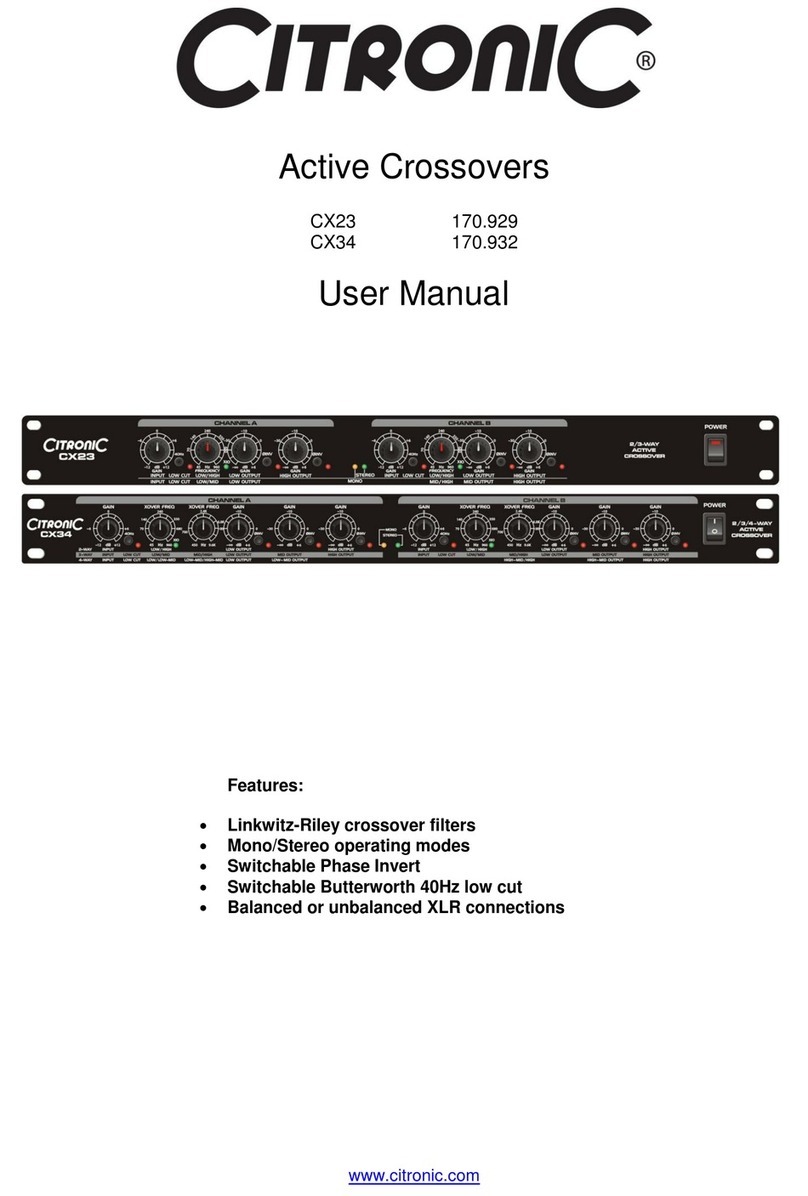
Citronic
Citronic CX23 Active Crossover user manual
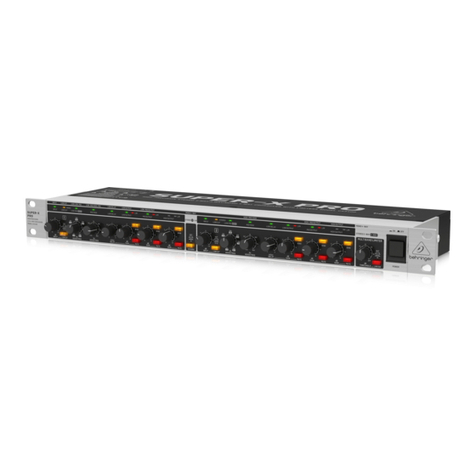
Behringer
Behringer Super-X Pro CX3400 user manual

Directed Electronics
Directed Electronics 202 owner's manual
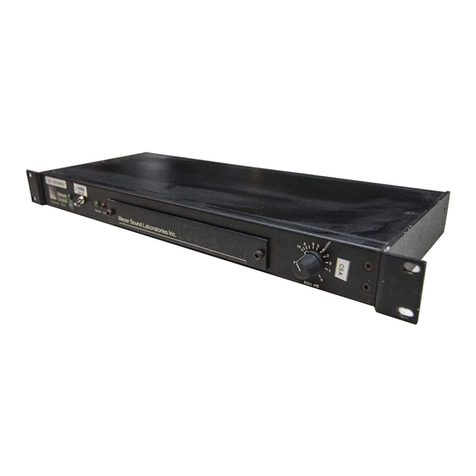
Meyer Sound
Meyer Sound B-2A operating instructions

Behringer
Behringer Super-X Pro CX3400 Technical specifications
